|
Bladderworts GENUS
Utricularia
There are well over 200 species of bladderworts worldwide.
Some are aquatic, and some are terrestrial, and some others are inbtween.
Aquatic are minorityWhen
the trigger hairs on the inner surface of the trap lobes are stimulated, the
clam-shell-shaped trap closes suddenly --- often in less than a half second ---
fast enough to capture such agile insects as a fly quite comfortably.
Intermeshing marginal spines effectively prevent the prey's escape. After the
initial rapid closure, the insect's struggle inside the trap further stimulates
the trigger hairs, causing the trap lobes to close even more tightly. In a
day or so, the trap is seen tightly sealed around the free margins of the lobes,
with the marginal spines pointing outwardly. The digesti
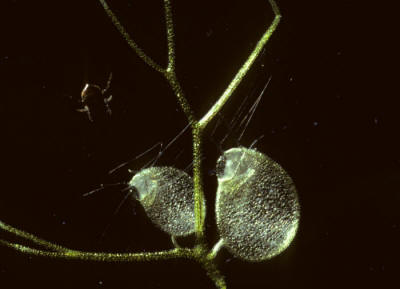 When
the trigger hairs on the inner surface of the trap lobes are stimulated, the
clam-shell-shaped trap closes suddenly --- often in less than a half second ---
fast enough to capture such agile insects as a fly quite comfortably.
Intermeshing marginal spines effectively prevent the prey's escape. After the
initial rapid closure, the insect's struggle inside the trap further stimulates
the trigger hairs, causing the trap lobes to close even more tightly. In a
day or so, the trap is seen tightly sealed around the free margins of the lobes,
with the marginal spines pointing outwardly. The digesti When
the trigger hairs on the inner surface of the trap lobes are stimulated, the
clam-shell-shaped trap closes suddenly --- often in less than a half second ---
fast enough to capture such agile insects as a fly quite comfortably.
Intermeshing marginal spines effectively prevent the prey's escape. After the
initial rapid closure, the insect's struggle inside the trap further stimulates
the trigger hairs, causing the trap lobes to close even more tightly. In a
day or so, the trap is seen tightly sealed around the free margins of the lobes,
with the marginal spines pointing outwardly. The digesti
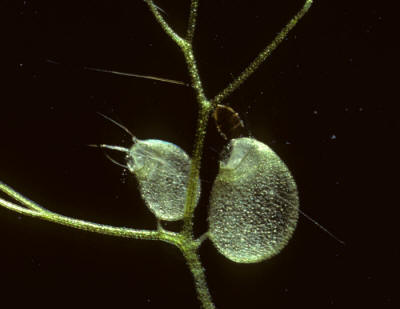 When
the trigger hairs on the inner surface of the trap lobes are stimulated, the
clam-shell-shaped trap closes suddenly --- often in less than a half second ---
fast enough to capture such agile insects as a fly quite comfortably.
Intermeshing marginal spines effectively prevent the prey's escape. After the
initial rapid closure, the insect's struggle inside the trap further stimulates
the trigger hairs, causing the trap lobes to close even more tightly. In a
day or so, the trap is seen tightly sealed around the free margins of the lobes,
with the marginal spines pointing outwardly. The digesti When
the trigger hairs on the inner surface of the trap lobes are stimulated, the
clam-shell-shaped trap closes suddenly --- often in less than a half second ---
fast enough to capture such agile insects as a fly quite comfortably.
Intermeshing marginal spines effectively prevent the prey's escape. After the
initial rapid closure, the insect's struggle inside the trap further stimulates
the trigger hairs, causing the trap lobes to close even more tightly. In a
day or so, the trap is seen tightly sealed around the free margins of the lobes,
with the marginal spines pointing outwardly. The digesti
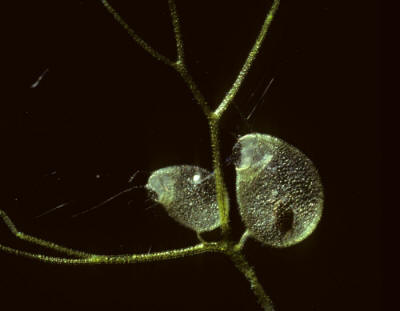 When
the trigger hairs on the inner surface of the trap lobes are stimulated, the
clam-shell-shaped trap closes suddenly --- often in less than a half second ---
fast enough to capture such agile insects as a fly quite comfortably.
Intermeshing marginal spines effectively prevent the prey's escape. After the
initial rapid closure, the insect's struggle inside the trap further stimulates
the trigger hairs, causing the trap lobes to close even more tightly. In a
day or so, the trap is seen tightly sealed around the free margins of the lobes,
with the marginal spines pointing outwardly. The digesti When
the trigger hairs on the inner surface of the trap lobes are stimulated, the
clam-shell-shaped trap closes suddenly --- often in less than a half second ---
fast enough to capture such agile insects as a fly quite comfortably.
Intermeshing marginal spines effectively prevent the prey's escape. After the
initial rapid closure, the insect's struggle inside the trap further stimulates
the trigger hairs, causing the trap lobes to close even more tightly. In a
day or so, the trap is seen tightly sealed around the free margins of the lobes,
with the marginal spines pointing outwardly. The digesti
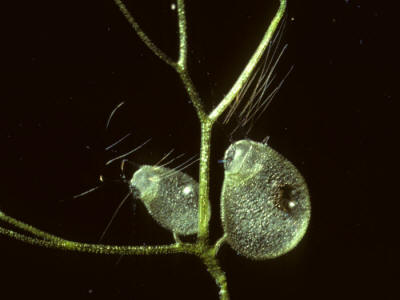 When
the trigger hairs on the inner surface of the trap lobes are stimulated, the
clam-shell-shaped trap closes suddenly --- often in less than a half second ---
fast enough to capture such agile insects as a fly quite comfortably.
Intermeshing marginal spines effectively prevent the prey's escape. After the
initial rapid closure, the insect's struggle inside the trap further stimulates
the trigger hairs, causing the trap lobes to close even more tightly. In a
day or so, the trap is seen tightly sealed around the free margins of the lobes,
with the marginal spines pointing outwardly. The digesti When
the trigger hairs on the inner surface of the trap lobes are stimulated, the
clam-shell-shaped trap closes suddenly --- often in less than a half second ---
fast enough to capture such agile insects as a fly quite comfortably.
Intermeshing marginal spines effectively prevent the prey's escape. After the
initial rapid closure, the insect's struggle inside the trap further stimulates
the trigger hairs, causing the trap lobes to close even more tightly. In a
day or so, the trap is seen tightly sealed around the free margins of the lobes,
with the marginal spines pointing outwardly. The digesti
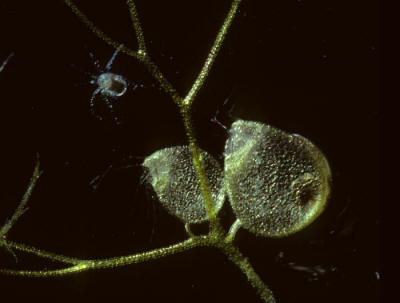 When
the trigger hairs on the inner surface of the trap lobes are stimulated, the
clam-shell-shaped trap closes suddenly --- often in less than a half second ---
fast enough to capture such agile insects as a fly quite comfortably.
Intermeshing marginal spines effectively prevent the prey's escape. After the
initial rapid closure, the insect's struggle inside the trap further stimulates
the trigger hairs, causing the trap lobes to close even more tightly. In a
day or so, the trap is seen tightly sealed around the free margins of the lobes,
with the marginal spines pointing outwardly. The digesti When
the trigger hairs on the inner surface of the trap lobes are stimulated, the
clam-shell-shaped trap closes suddenly --- often in less than a half second ---
fast enough to capture such agile insects as a fly quite comfortably.
Intermeshing marginal spines effectively prevent the prey's escape. After the
initial rapid closure, the insect's struggle inside the trap further stimulates
the trigger hairs, causing the trap lobes to close even more tightly. In a
day or so, the trap is seen tightly sealed around the free margins of the lobes,
with the marginal spines pointing outwardly. The digesti
The nectar seeker is forced to
position itself between the trap lobes. Three pairs of innocuous-looking
bristles grow on the inner surface of the lobes. The visitor to the Venus' diner
has no way of knowing what will precipitate if these sensitive hairs are
disturbed.
ed through the
leaf and are carried away to the other parts of the plant.
Introduction
Venus Flytrap
Sundews
Pitcher Plants
Cobra Plant
Butterworts
Bladderworts
|




